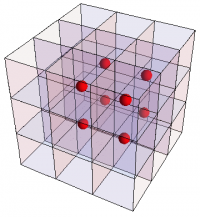Triple Integrals
Integration in three dimensions is still about chopping and adding. For example, to find the total amount of chocolate in a region in space given its mass density $\rho$, first chop the region into small “boxes”, as indicated symbolically in Figure 1. How big are the pieces? Surely
\begin{equation} dV = dx \,dy \,dz \end{equation} What is the mass of each such piece? Clearly, $\rho \,dV$. Since $\rho$ is not constant, the total mass is given by \begin{equation} M = \int \rho \,dV \end{equation} Since we are working in rectangular coordinates, we can write $\rho=\rho(x,y,z)$, so that the total mass is now \begin{equation} M = \TInt{} \rho(x,y,z) \,dx\,dy\,dz \end{equation}
This is a triple integral. How does one evaluate such an integral? Not surprisingly, one integrates three times. So long as the limits are constant, it does not matter in which order you do the integrals.
